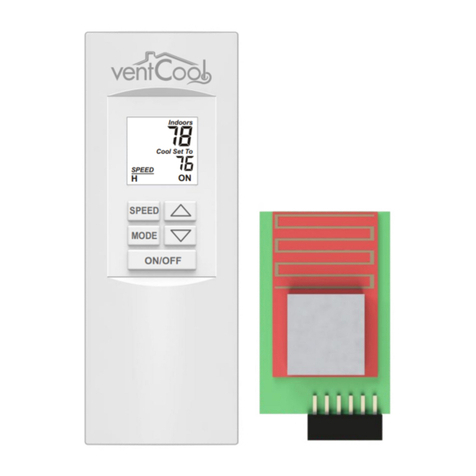
page 5 of 20
VENTILATION REQUIREMENTS
It is very important that the attic be suciently ventilated for the fan system to operate properly. Without
adequate ventilation, hot air exhausted from the home cannot easily escape from the attic, which creates
back-pressure that will substantially reduce the fan’s performance. Operating this fan in an attic with less net
free ventilation area than recommended will decrease its airow and energy eciency.
If subject to the California Title 24 requirements for whole-house fan ventilation, the fan system must be installed
If subject to the California Title 24 requirements for whole-house fan ventilation, the fan system must be installed
to the minimum ventilation requirements as found in the standard.
to the minimum ventilation requirements as found in the standard.
In the absence of applicable local code regarding whole-house ventilation, we recommend a minimum of 1
In the absence of applicable local code regarding whole-house ventilation, we recommend a minimum of 1
square
foot of “net free” ventilation area per 500 cfm at a fan’s highest speed for proper operation.
foot of “net free” ventilation area per 500 cfm at a fan’s highest speed for proper operation.
Refer to specication
table for required Net Free Ventilation Area in Attic at HVI fan rating.
table for required Net Free Ventilation Area in Attic at HVI fan rating.
Net
Free Ventilation Area
can be provided by any combination of gable, eyebrow, roof cap, sot, or ridge
can be provided by any combination of gable, eyebrow, roof cap, sot, or ridge
vents, or any other method of ventilating the attic space. The openings of most vents are partially obstructed
vents, or any other method of ventilating the attic space. The openings of most vents are partially obstructed
by grilles, louvers, and/or screens. A vent’s “net free” ventilation area is the surface area of its opening minus the
by grilles, louvers, and/or screens. A vent’s “net free” ventilation area is the surface area of its opening minus the
surface area of any grilles, louvers, or screening covering it. Dierent types of vents have dierent ratios of net free
surface area of any grilles, louvers, or screening covering it. Dierent types of vents have dierent ratios of net free
area to total area.
While most properly constructed homes have adequately ventilated attics, not all do. Because sucient
While most properly constructed homes have adequately ventilated attics, not all do. Because sucient
ven
tilation is a very strong factor in this fan’s performance, it is important that the home’s existing ventilation be
tilation is a very strong factor in this fan’s performance, it is important that the home’s existing ventilation be
veried before it is installed.
veried before it is installed.
Manufacturers typically publish their vents’ net free ventilation areas and/or ratios in their products’
Manufacturers typically publish their vents’ net free ventilation areas and/or ratios in their products’
specication documents. If this information is unavailable, a ratio of 50% net free area to total area is usually a good
specication documents. If this information is unavailable, a ratio of 50% net free area to total area is usually a good
rule of thumb. A notable exception to this rule of thumb are ridge vents. The industry standard net free ventilation
rule of thumb. A notable exception to this rule of thumb are ridge vents. The industry standard net free ventilation
area for ridge vents is 13% of the vent’s length in feet.
area for ridge vents is 13% of the vent’s length in feet.
Since most attics have multiple vents, often of dierent types, it is necessary to count each vent, noting its type
Since most attics have multiple vents, often of dierent types, it is necessary to count each vent, noting its type
and size. Apply the appropriate ratio to the dimensions of each vent to nd its net free area, and sum these
and size. Apply the appropriate ratio to the dimensions of each vent to nd its net free area, and sum these
values to nd the attic’s total ventilation. An example of how these calculations are made is given in the
values to nd the attic’s total ventilation. An example of how these calculations are made is given in the
table below:
Vent Type Dimensions Total Area
Net Free Area Ratio
(“NFA”)
Net Free Ventilation Area
(=Total Area x NFA)
Two Louvers 24” x 24” 24” x 24”/ 144 = 4 ft.250% 2 x 4 ft.2x .50 = 4 ft.2
Ridge 32 feet n/a 13% 32 feet x .13 = 4.16 ft.2
Round Sot 10” diameter 3.14 x 5” x 5” / 144 = .55 ft.250% .55 ft.2 x .50 = 0.28 ft.2
Total Net Free Ventilation Area: 8.44 ft.2
Please consult a roong professional if the attic’s net free ventilation area remains uncertain. Additional ventilation
may be required for proper operation of the fan system.
P/N 780102000 07/20 Rev F
Refer to specication table for required minimum Open Window Ventilation Area in square feet when operating
Refer to specication table for required minimum Open Window Ventilation Area in square feet when operating
whole house fan. Without adequate Open Window Ventilation Area, the quantity of cooler air pulled into the home
whole house fan. Without adequate Open Window Ventilation Area, the quantity of cooler air pulled into the home
to be exhausted to the attic may substantially reduce the fans overall performance.
to be exhausted to the attic may substantially reduce the fans overall performance.




























